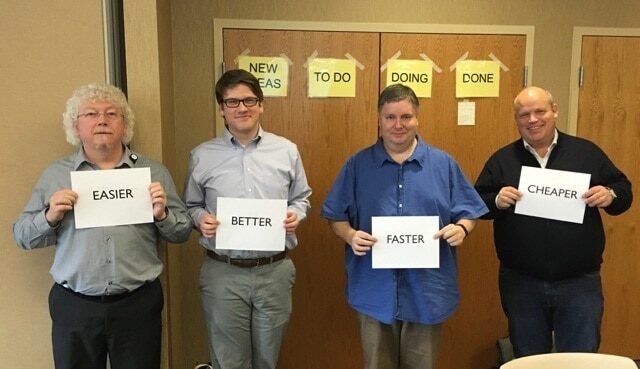Hear Mark read this post (subscribe to the podcast):
Follow the two main days of our “Kaizen Live” event and site visit at Franciscan St. Francis Health the next two days on Twitter using the hashtag #KaizenLive.
Last year, at our “Kaizen Live” optional pre-class, we talked about the priorities of continuous improvement, as taught by Shigeo Shingo and then Masaaki Imai, as I blogged about here.
Here is a picture of participants who arranged the famous priorities into what's considered the correct order in Lean:

- Easier
- Better
- Faster
- Cheaper
Per Shingo:

He says “priority.” He doesn't say cheaper doesn't matter. Lean thinkers see that cheaper is the end result of easier, better, and faster.
Yesterday, in our discussion, somebody raised a great question:
What if “easier” is less safe?
Great question. It begs the question of why Safer isn't first in Shingo's list?
Is it because safety is assumed to be such a fundamental pre-condition in the Toyota culture or the Lean approach? Safety is such a non-negotiable point that it doesn't need to be said?
ThedaCare's CEO Dean Gruner asked if we can't do anything safely, why do it at all? I blogged about this here:
There's a similar discussion about the “5S” methodology.
Some organizations take the original 5Ss, which are mainly about reducing waste, making problems visible, and organizing the workplace, to add SAFETY as “the 6th S.” As Wikipedia says, 6S is a modification of 5S.
Well, yes, safety starts with S. Why isn't is part of 5S? Again, maybe it's that Safety is a necessary and required pre-condition for everything else. Safety is the priority, so why would you need to state it in the 5S program context just because it starts with S.
Security is important, but we don't add that to make it a 7th S?
But, still…. should we teach the priorities of improvement as this?
- Safer
- Easier
- Better
- Faster
- Cheaper
What do you think? Does your organization really make safety (or patient safety) the top priority?
I recently saw a discussion about Tom Brady and (alleged) concussions in the NFL in this Wall Street Journal article.
“The NFL released a statement that was expertly NFL, saying it had reviewed its records and found no evidence of a Brady head injury or concussion during the 2016 season. It vowed to gather more information. “The health and safety of our players is our foremost priority,” the league statement said.”
Is that really true? I've been a football fan, but I'm starting to think the game is inherently dangerous. If health and safety were REALLY the first and foremost priority, would they shut the doors and end the league? Or are they saying that a reasonable level of risk is acceptable, given all of the money everybody makes, including the players?
Should they change their name to the NSFL, the National Safe Football League?
What are your thoughts on any of this?
Please scroll down (or click) to post a comment. Connect with me on LinkedIn.
Let’s work together to build a culture of continuous improvement and psychological safety. If you're a leader looking to create lasting change—not just projects—I help organizations:
- Engage people at all levels in sustainable improvement
- Shift from fear of mistakes to learning from them
- Apply Lean thinking in practical, people-centered ways
Interested in coaching or a keynote talk? Let’s start a conversation.









![When Was the Last Time a Leader Around You Admitted They Were Wrong? [Poll]](https://www.leanblog.org/wp-content/uploads/2025/07/Lean-Blog-Post-Cover-Image-2025-07-01T212509.843-100x75.jpg)
For me, one of the most problematic issues with including Safety as part of a 5S program, is that it can drive the wrong behavior. For a significant number of organizations, the activity driver of the 5S program is the audit, which may occur only once a month. By adding Safety as part of the 5S activity/audit, it can therefore cause people to reduce their vigilance with potential safety issues, because “the 6S audit will catch it”, which isn’t desirable, even if there are frequent audits.
It’s also well known that 5S is one of the more difficult initiatives to sustain for organizations, in large part because it is often one of the first initiatives attempted, so the organization has to go through a learning process to understand which aspects and approaches work best for the organization. Including Safety as one of the aspects in that learning process …
Comments from LinkedIn:
Sid Joynson
There are two things missing from the list of focus for our improvement activities.
We need to make our activities, Easier, Better, Faster and Cheaper. Missing are Safer and more Enjoyable/Fun.
Easier – Faster – Safer – Enjoyable/Fun for ourselves.
Better, Quality, Cost, Delivery and Delight for the customer.
What is not to like!
Our ultimate goal is to create organisations that can compete successfully in the global market now and in the future, and are secure, challenging, fulfilling, and enjoyable/fun places to work. —
“I don’t just want a company to work in. I want one I can believe in.” Anita Roddick.
I observed a situation this week that reinforced to me the value of integrating safety into a 5S program. During a 5S audit of a workshop an auditor observed some glassware sitting near a sink, being out of place and therefore not in compliance with the sort section of the audit. What was not noted by this auditor, but was noted by a second auditor who was a safety specialist, was that the glassware was right next to the eyewash station. In other words, not only was there an issue with something being out of place, there was an identified safety risk of storing glassware in immediate proximity to the eyewash station.
Such an observation occurred because one of the auditors had eyes to see safety…and the auditor had eyes to see safety because of the inclusion of safety as a key component in the 5S (now 6S) program to create a safe and stable system upon which to build continuous improvement. Safety may be an assumed pre-condition in Toyota culture, but that does not necessarily mean that such is the case in all companies. Adding a sixth “S” to 5S can help to rectify this.
Easier, Better, Faster and Cheaper is the process of QCC team development process.
While Safety, Quality, Cost & Delivery is a result aspect which should be “incorperate” into each stage of QCC development as the impact result or opportunity.
Most people are confuse between “result”and “process”.
From my thought, when Dr. Shingo emphasize Easier, Better, Faster, and Cheaper, he view it from the aspect of people development process.